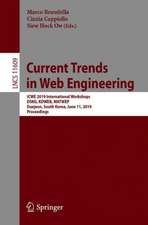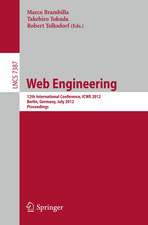Designing Data-Intensive Web Applications: The Morgan Kaufmann Series in Data Management Systems
Autor Stefano Ceri, Piero Fraternali, Aldo Bongio, Marco Brambilla, Sara Comai, Maristella Materaen Limba Engleză Paperback – 3 ian 2003
Din seria The Morgan Kaufmann Series in Data Management Systems
- 34%
 Preț: 392.54 lei
Preț: 392.54 lei - 36%
 Preț: 310.89 lei
Preț: 310.89 lei - 20%
 Preț: 549.28 lei
Preț: 549.28 lei - 20%
 Preț: 423.79 lei
Preț: 423.79 lei - 20%
 Preț: 453.27 lei
Preț: 453.27 lei - 20%
 Preț: 557.64 lei
Preț: 557.64 lei - 20%
 Preț: 861.54 lei
Preț: 861.54 lei - 20%
 Preț: 750.58 lei
Preț: 750.58 lei - 20%
 Preț: 589.11 lei
Preț: 589.11 lei - 20%
 Preț: 398.97 lei
Preț: 398.97 lei - 20%
 Preț: 553.31 lei
Preț: 553.31 lei - 35%
 Preț: 243.25 lei
Preț: 243.25 lei - 20%
 Preț: 402.52 lei
Preț: 402.52 lei - 20%
 Preț: 449.34 lei
Preț: 449.34 lei - 20%
 Preț: 827.30 lei
Preț: 827.30 lei - 31%
 Preț: 237.87 lei
Preț: 237.87 lei - 20%
 Preț: 268.09 lei
Preț: 268.09 lei - 20%
 Preț: 560.60 lei
Preț: 560.60 lei - 20%
 Preț: 517.90 lei
Preț: 517.90 lei - 20%
 Preț: 398.74 lei
Preț: 398.74 lei - 20%
 Preț: 628.30 lei
Preț: 628.30 lei - 20%
 Preț: 476.28 lei
Preț: 476.28 lei - 20%
 Preț: 148.30 lei
Preț: 148.30 lei - 20%
 Preț: 782.30 lei
Preț: 782.30 lei - 20%
 Preț: 869.95 lei
Preț: 869.95 lei - 20%
 Preț: 941.84 lei
Preț: 941.84 lei - 16%
 Preț: 184.00 lei
Preț: 184.00 lei - 30%
 Preț: 301.70 lei
Preț: 301.70 lei - 20%
 Preț: 648.76 lei
Preț: 648.76 lei - 20%
 Preț: 367.92 lei
Preț: 367.92 lei - 20%
 Preț: 606.38 lei
Preț: 606.38 lei - 20%
 Preț: 584.49 lei
Preț: 584.49 lei - 20%
 Preț: 612.63 lei
Preț: 612.63 lei - 20%
 Preț: 505.62 lei
Preț: 505.62 lei - 20%
 Preț: 617.57 lei
Preț: 617.57 lei - 20%
 Preț: 550.29 lei
Preț: 550.29 lei - 20%
 Preț: 563.24 lei
Preț: 563.24 lei - 29%
 Preț: 379.06 lei
Preț: 379.06 lei - 33%
 Preț: 278.29 lei
Preț: 278.29 lei - 32%
 Preț: 189.98 lei
Preț: 189.98 lei - 32%
 Preț: 281.67 lei
Preț: 281.67 lei - 20%
 Preț: 455.09 lei
Preț: 455.09 lei - 20%
 Preț: 466.95 lei
Preț: 466.95 lei - 20%
 Preț: 512.32 lei
Preț: 512.32 lei - 20%
 Preț: 231.88 lei
Preț: 231.88 lei - 8%
 Preț: 355.29 lei
Preț: 355.29 lei
Preț: 665.15 lei
Preț vechi: 831.44 lei
-20% Nou
Puncte Express: 998
Preț estimativ în valută:
127.27€ • 133.24$ • 105.31£
127.27€ • 133.24$ • 105.31£
Carte tipărită la comandă
Livrare economică 05-19 aprilie
Preluare comenzi: 021 569.72.76
Specificații
ISBN-13: 9781558608436
ISBN-10: 1558608435
Pagini: 562
Dimensiuni: 187 x 235 x 30 mm
Greutate: 0.97 kg
Ediția:New.
Editura: ELSEVIER SCIENCE
Seria The Morgan Kaufmann Series in Data Management Systems
ISBN-10: 1558608435
Pagini: 562
Dimensiuni: 187 x 235 x 30 mm
Greutate: 0.97 kg
Ediția:New.
Editura: ELSEVIER SCIENCE
Seria The Morgan Kaufmann Series in Data Management Systems
Public țintă
Database professionals and practitioners, software developers, IT professionals.Recenzii
"...present
a
methodology
that
fully
exploits
the
conceptual
modeling
approach
of
software
engineering,
from
idea
to
application."
As described by the authors, the goal of this book is the proposal of a mix of concepts, notations, and techniques for the construction of data-intensive Web applications, which can be used by Web development teams to support all the activities of the application lifecycle, from analysis to deployment and evolution.The authors achieve this purpose, and provide an easy to read, but more importantly, an easy to follow set of instructions, methods, and examples to guide programmers in moving to the data-intensive applications that the more dynamic Web and portal technologies require. The books combination and extension of known modeling techniques in a new constellation, to create a new software engineering technique, may well prove to be its major contribution. The creativity of the combination of techniques to form a method is remarkable, as is the books easy pedagogic style. A conceptual modeling language, Web Markup Language (WebML) is introduced in the text. This language follows the entity-relationship (E-R) model and Universal Markup Language (UML) syntax, and thus will be natural for those familiar with E-R and UML. This language is used to guide the reader in specifying and designing a Web application, including requirements specification, data design, and hypertext design. A data intensive Web application is a Web site that accesses and maintains large amounts of structured data. Most current Web sites and emerging application sites are of this nature. Four major sections are contained in the book. The first section is a technology overview that gives the reader a basic foundation in Web application software. Models for designing Web applications are covered in the second section, which covers the E-R modeling tools and UML in a very readable way that leads to the introduction of hypertext and content modeling. Section 3 covers the design of these models, and the development of these models into something that can be implemented. Finally, the last section covers implementation techniques, starting with an architecture for creating such implementations. The text is presented in a clear and very easy to understand style. Examples abound. The book is intended for those who wish to learn these techniques in order to apply them in Web and portal applications. The authors indicate that this book might be used as a text for a course in Web design. For the practitioner who has a basic understanding of data systems, this text would be a very concise and useful book to help create and document applications. If used as an undergraduate text for an elective, this book could provide students with a very useful set of sound modeling techniques, software engineering principles, and best practices for important systems currently in development across the world. The applicability of these software engineering and modeling techniques to data intensive sites with structured and unstructured data is apparent, as long as there is structured metadata associated with the unstructured data. Thus, it would seem this book has significant practical value to all those creating Web sites, community communication sites, and portal applications,and in the creation of sites in the foreseeable future.--E.A. Unger, ACM Communications
As described by the authors, the goal of this book is the proposal of a mix of concepts, notations, and techniques for the construction of data-intensive Web applications, which can be used by Web development teams to support all the activities of the application lifecycle, from analysis to deployment and evolution.The authors achieve this purpose, and provide an easy to read, but more importantly, an easy to follow set of instructions, methods, and examples to guide programmers in moving to the data-intensive applications that the more dynamic Web and portal technologies require. The books combination and extension of known modeling techniques in a new constellation, to create a new software engineering technique, may well prove to be its major contribution. The creativity of the combination of techniques to form a method is remarkable, as is the books easy pedagogic style. A conceptual modeling language, Web Markup Language (WebML) is introduced in the text. This language follows the entity-relationship (E-R) model and Universal Markup Language (UML) syntax, and thus will be natural for those familiar with E-R and UML. This language is used to guide the reader in specifying and designing a Web application, including requirements specification, data design, and hypertext design. A data intensive Web application is a Web site that accesses and maintains large amounts of structured data. Most current Web sites and emerging application sites are of this nature. Four major sections are contained in the book. The first section is a technology overview that gives the reader a basic foundation in Web application software. Models for designing Web applications are covered in the second section, which covers the E-R modeling tools and UML in a very readable way that leads to the introduction of hypertext and content modeling. Section 3 covers the design of these models, and the development of these models into something that can be implemented. Finally, the last section covers implementation techniques, starting with an architecture for creating such implementations. The text is presented in a clear and very easy to understand style. Examples abound. The book is intended for those who wish to learn these techniques in order to apply them in Web and portal applications. The authors indicate that this book might be used as a text for a course in Web design. For the practitioner who has a basic understanding of data systems, this text would be a very concise and useful book to help create and document applications. If used as an undergraduate text for an elective, this book could provide students with a very useful set of sound modeling techniques, software engineering principles, and best practices for important systems currently in development across the world. The applicability of these software engineering and modeling techniques to data intensive sites with structured and unstructured data is apparent, as long as there is structured metadata associated with the unstructured data. Thus, it would seem this book has significant practical value to all those creating Web sites, community communication sites, and portal applications,and in the creation of sites in the foreseeable future.--E.A. Unger, ACM Communications
Descriere
Explores the conceptual modeling approach of software engineering, from idea to application. This work helps to learn not only how to harness the design technologies of relational databases for use on the Web, but also how to transform their conceptual designs of data-intensive Web applications into effective software components.


















